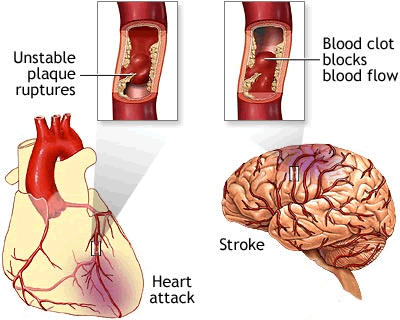Hepatitis
C Patients May Have Increased Risk of Stroke
 |
 |
 |
 |
| SUMMARY:
People with chronic hepatitis
C virus (HCV) infection appear to have a higher likelihood
of dying from strokes than uninfected individuals, according
to research reported in the December
2010 issue of Stroke. Over 17 years of follow-up,
nearly 3% of HCV seropositive people died due to cerebrovascular
events, compared with 1% of HCV negative people; furthermore,
the risk of stroke death rose with increasing HCV viral
load. |
|
 |
 |
 |
 |
By
Liz Highleyman
Chronic hepatitis C has been
linked to numerous co-existing conditions including metabolic
abnormalities and cardiovascular
disease. While researchers often include strokes when counting
cardiovascular events, the association between HCV infection
and stroke in particular has not been established.
Mei-Hsuan Lee from National Taiwan University and colleagues
performed a study to assess the risk of lethal cerebrovascular
diseases -- or problems related to blood flow in the brain --
associated with chronic HCV infection.
Strokes are caused by interruption of the brain's blood supply,
either due to blockage (ischemic stroke) or bleeding (hemorrhagic
stroke). Blockage can occur when blood clots triggered by atherosclerosis
-- especially buildup of plaque in the carotid arteries that
supply the brain -- break off and lodge in small blood vessels.

This community-based prospective cohort study enrolled 23,665
Taiwan residents age 30-65 during 1991-1992. Of these, 1307
people, or about 6%, were HCV seropositive. At the time of enrollment
participants were interviewed in person using structured questionnaires
and provided blood samples for testing. They were followed through
2008, and deaths due to cerebrovascular causes were confirmed
using National Death Certification data.
Results
 |
A
total of 255 cerebrovascular deaths were recorded during
382,011 person-years of follow-up. |
 |
The
cumulative risk of cerebrovascular deaths was 1.0% for HCV
seropositive participants versus 2.7% for HIV seronegative
individuals, a significant difference (P < 0.001). |
 |
After
adjusting for known stroke risk factors, the hazard ratio
of cerebrovascular death for people with HCV was 2.18, or
about twice the risk. |
 |
Risk
of stroke rose with higher HCV RNA levels: |
 |
 |
Hazard
ratio 1.40 for undetectable viral load; |
 |
Hazard
ratio 2.36 for low viral load; |
 |
Hazard
ratio 2.82 for high viral load. |
|
 |
There
was no significant association, however, between stroke
risk and HCV genotype. |
Based on these findings, the study authors concluded, "Chronic
HCV infection is an independent risk predictor of cerebrovascular
deaths showing a biological gradient of cerebrovascular mortality
with increasing serum HCV RNA level."
"The frequency and intensity of infection might be associated
with the progression of atherosclerosis," they suggested
in their discussion. "Infection affects atherothrombosis
[clotting] by triggering a cascade of immune responses and inflammatory
stimuli either locally within vascular tissue or systemically
through inflammatory mediators."
"Elevated serum HCV RNA level was associated with an increased
risk of cerebrovascular death, suggesting that individuals with
an active HCV infection may trigger a stronger inflammation response
by host-virus interaction leading to atherothrombosis," they
continued. "Whether patients with persistent HCV infection
had increased circulating levels of inflammation markers such
as C-reactive protein or endothelial progenitor cells may provide
insights on the mechanisms of HCV infection and cerebrovascular
disease."
Investigator affiliations: Graduate Institute of Epidemiology,
College of Public Health, National Taiwan University, Taipei,
Taiwan; Genomics Research Center, Academia Sinica, Taipei, Taiwan;
Department of Cardiology, Cardinal Tien Hospital, College of Medicine,
Fu-Jen Catholic University, Taipei, Taiwan; Department of Microbiology,
National Taiwan University, Taipei, Taiwan; Department of Internal
Medicine, National Taiwan University Hospital, Taipei, Taiwan.
2/1/11
Reference
M-H
Lee, H-I Yang, C-H Wang, and others. Hepatitis C virus infection
and increased risk of cerebrovascular disease. Stroke
41(12): 2894-2900 (Abstract).
December 2010.
|
| |
|
|
